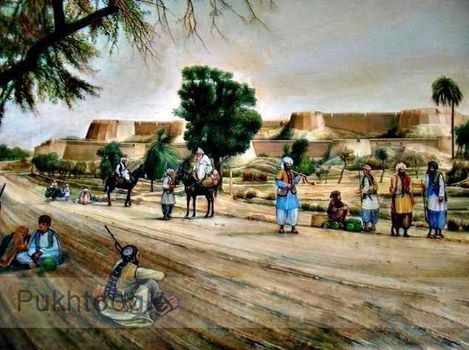As Many Of Us Don't Know About The History Of Bala Hisar Fort Peshawar, Today I Am Going To Share About Its Origin & History.
Name: As Far As The Name Is Concern It's Established That The Name `Bala Hisar` Was Given By Afghan/Pushtoon Ruler Taimoor Shah Durrani (1773-1793) Who Was The Son Of Ahmad Shah Durrani The Ist Emperor Of Durrani Empire. Bala Hisar Has A Persian Connotation, Bala Means On Top & Hisaar Means Obstacle Or Safety. Later When Sikhs Captured It From Durranis In 1834, They Renamed It As `Samir Garh`, But It Did Not Become Popular.
Origin: The Question That Who Built It And Where Does It Exactly Dates Back Is Not Clear & This Is Because Of The History Of City Where It Is Located. Peshawar's History Is Very Old And Due To Its Geo Strategic Location It Has Been A City Most Vulnerable To Invaders. However It Is Believed That History Of Fort Is As Old As Peshawar. The Most Prevalent Claim Is That Mughals Built The Fort But Its Not True, Because Mughal Rulers Wrote Diaries & It Has Never Been Mentioned In Any Mughal Writing That They Built It, Even Babar Who Was Renowned For His Writing Did Not Mention Abt Any Such Claim. Moreover A Renowned Historian Dr. Ahmad Hasan Dani In His Book “Peshawar - Historic City of Frontier” Writes That ...
"when Hiuen Tsang visited Peshawar (630 AD), he speaks of a ‘royal residence’. He says that the Chinese words ‘Kung Shing’ used for it is significant and is explained as fortified or walled portion of the town in which the royal palace stood. Hiuen Tsang then makes a separate mention of the city which was not fortified. This shows that the royal residence formed the nucleus of a Citadel, which must have been further protected by a moat. Dr. Dani further says that channel of old Bara river surrounded a high spot which includes the Bala Hisar and Andar Shahr. The higher area could have been Citadel which is the present Bala Hisar".
So We Can Say That It Is Not Known Who Exactly Choosed The Location And Whose Idea It Was To Built It. Its History Is As Old As Of The City Which It Is Located In. However As Peshawar Had Been Under Many Rulers Of Different Dynasties & Empires Due To Which The Fort Was Destroyed & Repaired Time To Time.
It Had Been Under Ghaznavids, Mughals, Durranis, Sikhs & British.
Under Ghaznavids:
Mahmud of Ghazni had defeated Hindu Rajas Jaipal and Anandpal in 1000 AD and 1006 AD respectively near Peshawar. The Raja’s forces must have sought strength and protection from the citadel of Peshawar, which was also protected by the surrounding channel of Bara River. Seeing the importance of the city, Mohammad Ghauri also took Peshawar in 1179 AD.
Under Mughals:
Babar’s Visits to Bagram: The great founder Mughal Emperor, Zahir ud Din Babar has frequently mentioned about the fort of Bala Hisar in his memories. He talks of this dismounting near Bigrarn (or Begrarn, old Peshawar) and then going out for hunting. He had also visited the great ‘tree’ the Pipal Mandi area, which Hiuen Tsang had seen, having four sitting figures of Budha underneath. Babar left the fort in the charge of Shah Mir Hussain before his onward march into India.
Under Emperor Humayun:
When Mughal Emperor Humayun was overthrown by the great Afghan King Sher Shah Suri, the Afghan destroyed Fort Bala Hisar also. While going to Kabul, Humayun however stayed at Peshawar and rebuilt Bala Hisar. Record of this event by Abul Fazal is quoted by Major Naimat in his article on Bala Hisar.
“After the overthrow of Emperor Humayun, by Sher Shah Suri, Afghans destroyed the fort of Begram (Peshawar). When Humayun was staying in the fort, he decided to rebuild it and garrison it and then proceed to Kabul. He wanted to use the fort for his conquest of India at a later stage. After returning from Persia he made use of the fort”.
Under the Durranis:
The Royal Residence: Ahmad Shah Durrani captured the fort from Moghuls and made it a residential palace.
Taimur Shah Durrani, the son of Ahmad Shah Durrani had made Peshawar his winter capital. While at Peshawar, his royal residence used to be in Bala Hisar Fort. However no buildings or structures of his days exist in the present fort. Taimur Shah kept a bodyguard of “Gholami Shahis” consisting of Persians and Tajiks for protection. In 1779, when a Khalil Chief Faizullah Khan forced his entry into Bala Hisar, the King was saved by the same bodyguards.
Under the Sikhs:
After the death of Taimur Shah Durrani in 1793, AD Shah Zaman became the King. However the Durrani rule weakened and the Sikhs rose to power in the Punjab. After the battle of Nowshera, the Sikhs captured Peshawar including Bala Hisar in 1834. At the time the fort was in a bad shape. Some accounts however indicate that the Sikhs first destroyed Bala Hisar but later realized its importance for protection and had to rebuild it. Either Hari Singh Nalwa or Sardar Khurruck Singh are said to have rebuilt the fort. However according to Raverty, Sher Singh, on the orders of his father Ranjeet Singh, erected the fort with un-burnt bricks. Sardar Tej Singh and General Evitable (1838-42) also stayed in Bala Hisar as Governors. While entering the main courtyard of the fort, a Sikh period inscription in marble can be seen on an arch gate. This is the only mark or inscription available today in Bala Hisar.
Under the British:
After the downfall of the Sikhs, Punjab was annexed by the British in 1849 and naturally Peshawar valley also became part of British India. At that time Bala Hisar had mud walls and was not very strong. The British replaced the whole structure with bricks and the present shape was given to Bala Hisar. Almost all the barracks that exist today were made by the British.
The British used to keep the troops in Bala Hisar till the cantonment was laid out. When the Afridi tribesmen launched an attack on the city in 1930, they fired guns from Bala Hisar Fort to stop Tribes men from entering the city.
Present:
A small museum has also been opened inside the fort which displays the weapons, dresses and other historical photographs etc related to the Frontier Corps. However, for entry to the fort, prior permission must be obtained.
fort Balla hisar pakistan
Posted on at



